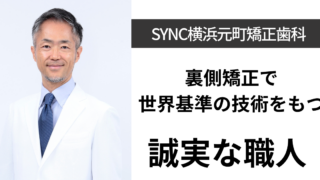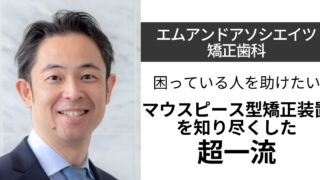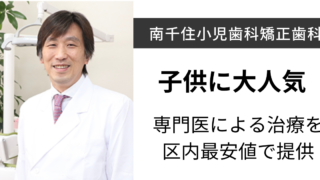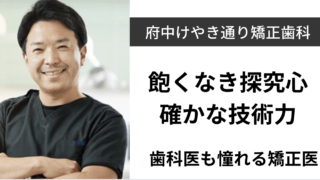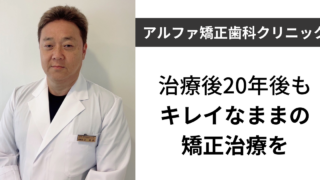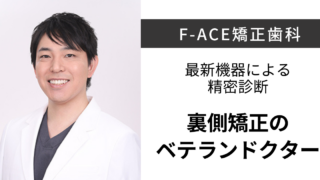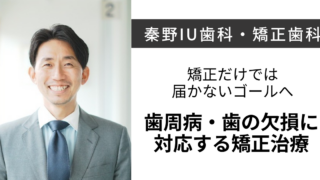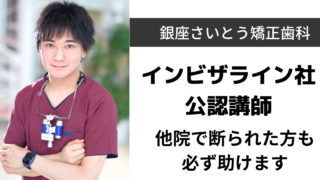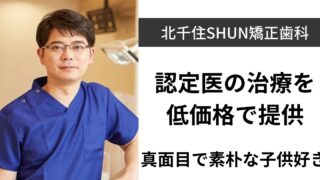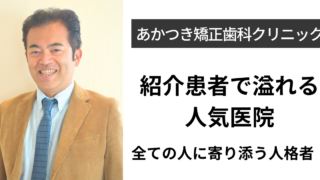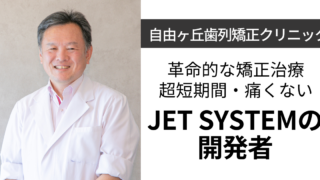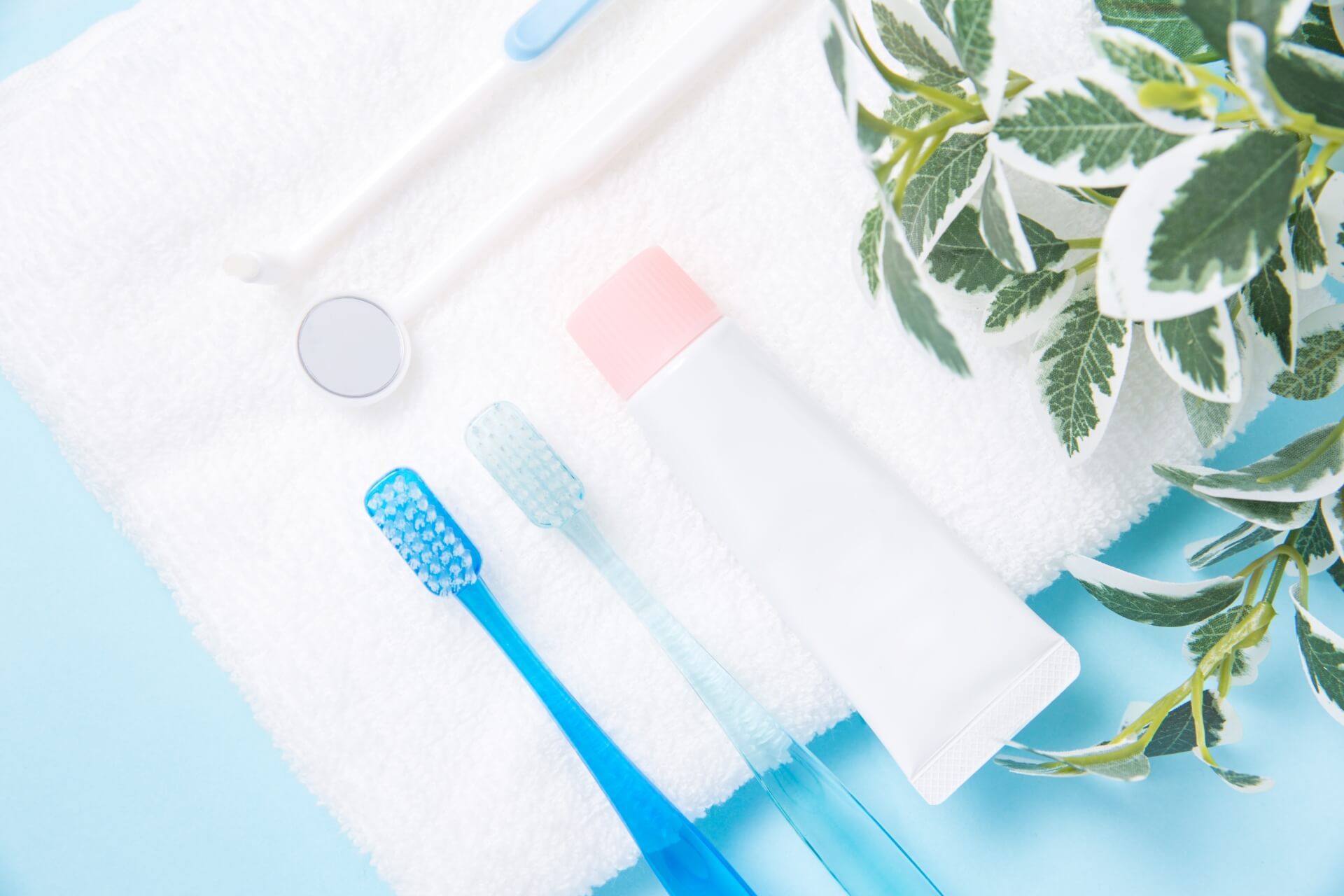
矯正中の歯磨きの仕方について教えます!
矯正中はワイヤー矯正、マウスピース矯正ともに、虫歯や歯周病、口臭のリスクが高くなります。これらのリスクをできるだけ抑えてきれいな歯並びを目指すには、毎日の歯磨きを丁寧に行うことが何より大切です。
今回は、矯正中の歯磨きについてお話しします。

ワイヤー矯正とマウスピース矯正に分けて、矯正中の歯磨きのポイントもご紹介しますね!
矯正中の歯磨きの心得

矯正中は装置が邪魔をするので、歯に食べかすや歯垢が溜まりやすくて落ちにくく、歯磨きで落としにくい状態となります。そのため、矯正前よりも丁寧な歯磨きが必要です。
使用する矯正装置に関わらず、以下のことを心がけましょう。
- 食事をしたら歯を磨くようにする
- 鏡を見ながら磨く
- 歯磨き粉は低発砲ものを使用する
- 軽い力で小刻みに歯ブラシを動かす
- 毛先が開いたら新しい歯ブラシに交換する
- 補助用具を使用する
食事をしたら歯を磨くようにする
食べかすがワイヤーやアタッチメントについて落ちにくくなるので、何か食べたあとは基本的に歯を磨くようにしましょう。食べかすは虫歯や歯周病、口臭を引き起こす素になります。
鏡を見ながら磨く
矯正中はワイヤーやアタッチメントなどが歯についているため、磨かなくてはいけない凹凸や面積が増えます。そのため、歯磨き中は歯ブラシが磨きたいところにきちんと当たっているか、鏡で確認しながら磨きましょう。
歯磨き粉は低発砲ものを使用する
泡立ちが良すぎる歯磨き粉は歯ブラシが当たっているか分かりにくく、口の中が泡でいっぱいになるため、矯正中の長時間の歯磨きには向いていません。
低発泡性で泡立ちが少ない歯磨き粉や、発泡剤が含まれないジェル状の歯磨き粉がおすすめです。また、フッ素入り歯磨き粉を使用すると虫歯予防に効果的です。
軽い力で小刻みに歯ブラシを動かす
強い力でゴシゴシ擦ると、歯や歯茎が傷ついてダメージを受ける恐れがあります。また、ワイヤー矯正の場合は装置に負担がかかったり、マウスピース矯正で歯につけるアタッチメントが削れたりすることがあります。
歯磨きをするときは、軽い力でシャカシャカと小刻みに磨くようにしましょう。歯ブラシはペンを持つように握ると力が入りにくくなり、歯ブラシも細かく動かしやすいです。
毛先が開いたら新しい歯ブラシに交換する
歯ブラシは、使用しているうちに毛先が曲がって外に開いたりブラシのコシがなくなったりして、汚れがしっかりと落とせなくなります。
矯正中はワイヤーの凸凹に毛先が引っかかり、特に歯ブラシの寿命が短くなります。毛先が開いていなくても、1ヶ月を目安に新しい歯ブラシに交換すると良いでしょう。
補助用具を使用する
歯と歯の間、ワイヤーの下や周りは歯ブラシが届きにくいので、どうしても磨き残しができてしまいます。ワイヤー矯正の場合は、毛先の小さなワンタフトブラシや歯間ブラシ、マウスピース矯正の場合はフロスなど、歯ブラシと一緒に補助用具を使用して歯垢を落としましょう。
関連記事:矯正中のおすすめグッズ
ワイヤー矯正中の歯磨きのポイント
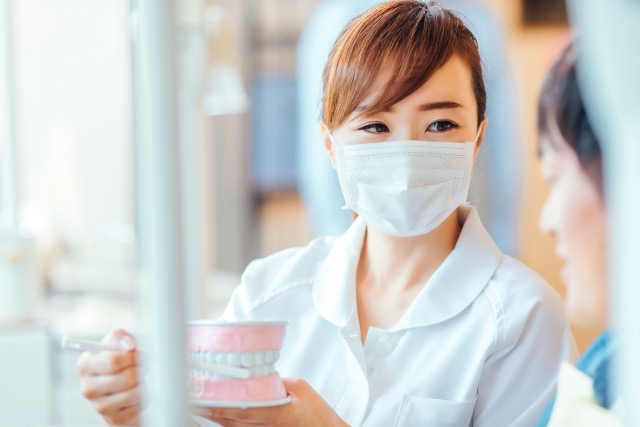
ワイヤー矯正で食べかすや磨き残しができやすいのは、ブラケットと歯の境目、ワイヤーの下の歯です。ここの汚れを落とすために、以下のポイントを意識して磨きましょう。
- ワイヤーに対して3方向から歯ブラシを当てる
- 細かい隙間には補助用具を使用する
ワイヤーに対して3方向から歯ブラシを当てる
ブラケットの周りに歯ブラシの毛先を当てるには、ワイヤーの上下と真上の3方向から歯ブラシを当てます。
ワイヤーの上下から磨くときは、ワイヤーに対して歯ブラシの側面を斜め45度に当てて、横方向に小刻みに動かします。ワイヤーの真上を磨くときは、器具に対して直角に歯ブラシを当てて、横方向に小刻みに磨きましょう。
小刻みに歯ブラシを動かすことで、ワイヤーの隙間に歯ブラシの毛先を入れ込んで歯垢を落とすことができます。
細かい隙間には補助用具を使用する
ワンタフトブラシ、歯間ブラシ、水流で歯を洗浄する口腔洗浄器を使用すると、さらに歯がきれいになります。
ワンタフトブラシの場合
ワンタフトブラシは、ブラケットの周りや歯並びのガタガタが残っている部分を磨くのにおすすめです。
ワイヤーの上下からブラシを潜り込ませるようにして、歯を磨きます。また、歯並びがガタガタして奥に引っ込んでいる歯やブラケットと歯の境目の角にピンポイントでワンタフトブラシを当て、歯ブラシのように小刻みに動かして磨くことでブラケットの周りがきれいになります。
歯間ブラシの場合
歯間ブラシはワンタフトブラシで届きにくいワイヤーの真下の歯を磨くのにおすすめです。ワイヤーの上下から歯間ブラシを潜り込ませて磨きます。
また、歯間ブラシは歯茎に埋め込んだ矯正用インプラントの周りをきれいにするときにも使用できます。歯間ブラシの側面を矯正用インプラントと歯茎の境目に当てて、角度を変えながら小刻みに動かして1周磨きます。
ジェットウォッシャーの場合
ジェットウォッシャーは、食べかすや汚れを水の力で洗い流す器械です。歯磨きをしたあとにワイヤーの下やブラケットの周りに洗浄器のノズルを入れ込むイメージで水流を当てて、浮き上がった食べかすや汚れを洗い流します。
ワイヤー矯正中の歯磨き動画
愛知県東海市にある小島歯科室様よりご提供頂きました。
非常に分かりやすい動画なので是非参考にしてみて下さい。
ちなみに動画で紹介されていたフロスはこちらです↓
マウスピース矯正中の歯磨きのポイント
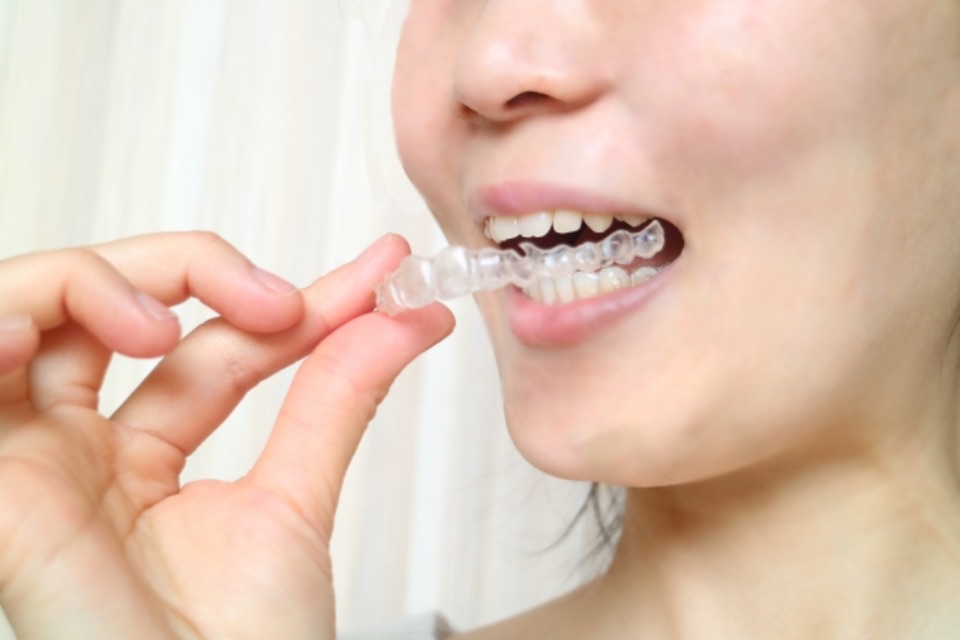
マウスピース矯正では、歯磨きの際にマウスピースを外せるので、ほとんど矯正前の歯磨きと同じケアが行えますが、マウスピース装着前のケアに気をつける必要があります。
- マウスピース装着の前に必ず歯磨きをする
- 歯磨きができないときはマウスウオッシュなどを活用する
この2つのポイントを意識して、口を清潔に保ちましょう。
マウスピース装着の前に必ず歯磨きをする
歯磨きをしないでマウスピースをつけると、食べかすや歯垢をマウスピースで密封することになり、虫歯や歯周病のリスクが格段に高くなります。マウスピース装着前は必ず歯磨きをしましょう。
歯ブラシを横方向に小刻みに動かし、歯を一本ずつ磨くイメージで満遍なく磨きましょう。また、歯と歯の間の歯垢は歯ブラシで落とせないため、フロスを使用して落とします。
歯を動かす過程で歯と歯の間に大きめの隙間ができる場合は、隙間のサイズに合った歯間ブラシを使用すると、効率的に汚れを落とせます。頬側か歯の裏側から歯と歯の間に歯間ブラシを差し込み、小刻みに押したり引いたりして磨きます。
歯磨きができないときはマウスウオッシュなどを活用する
マウスピースの装着前に歯磨きが必要とはいっても、ライフスタイルによってはマウスピース装着前の歯磨きが難しい場合もあります。
そのときは、マウスピース装着の前によくブクブクうがいをして、できるだけ食べかすが歯についていない状態でマウスピースを装着します。可能であれば、殺菌効果や虫歯予防効果のあるマウスウォッシュを使用してうがいをすると、口内細菌の活動が抑えられるのでおすすめです。
歯磨きができないときにマウスピースをつけるのを止めてしまうと歯が動かないため、マウスピースの作り直しや矯正期間の延長が必要になります。
歯磨きができないときは、食後のうがいを行ったうえでマウスピースの装着を優先し、食後のタイミングに関わらずできるタイミングで歯磨きを行うようにしましょう。
矯正中の歯磨きはきれいな口元への第一歩
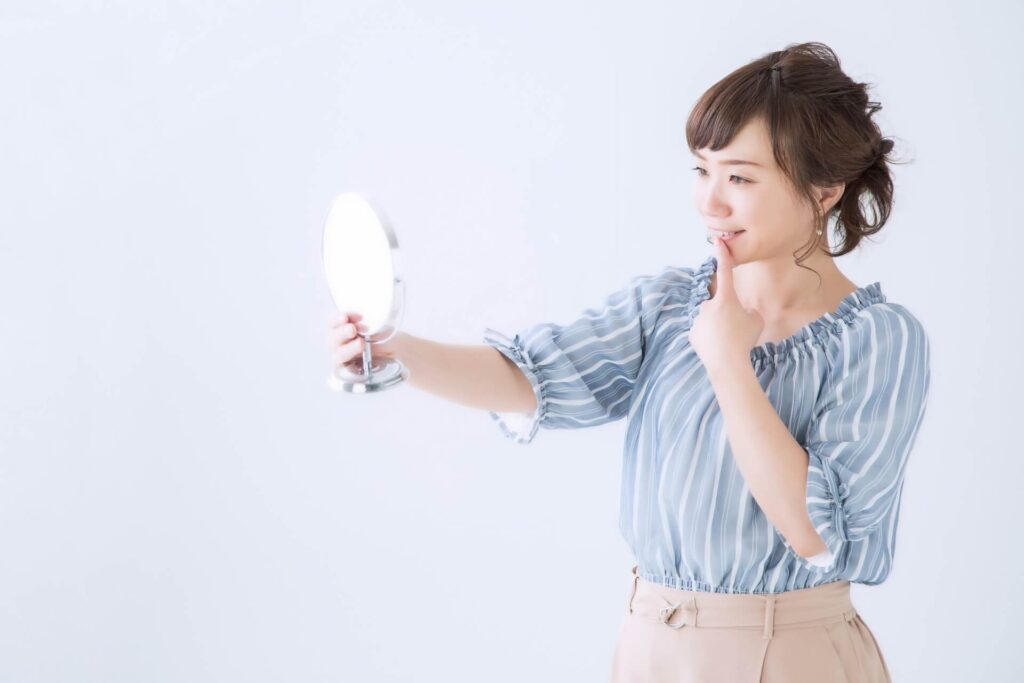
矯正中の歯磨きは普段よりも手間がかかりますが、きれいな歯並びには丁寧にケアされた健康な歯が欠かせません。矯正中の歯磨きはきれいな口元への第一歩と心得て、しっかりケアしましょう。
365dentistでは歯科医院選びのお手伝いやお口のお役立ち情報を掲載中です!
歯科医院選びに迷っている方は公式ライン、矯正に関するお悩みをお話ししたい方はオープンチャットに遊びに来てくださいね!
関連記事:歯磨き粉に含まれてるフッ素の効果とは?危険って本当?
関連記事:矯正と虫歯の関係
365dentist総監修 歯科医師/勝屋友紀子
長崎大学歯学部卒業、〜2018 九州医療センター、2018〜現在 都内歯科クリニック勤務
監修 歯科医師/Naomi
臨床研修終後、都内審美歯科勤務。現在は歯科医師/歯科ライター

